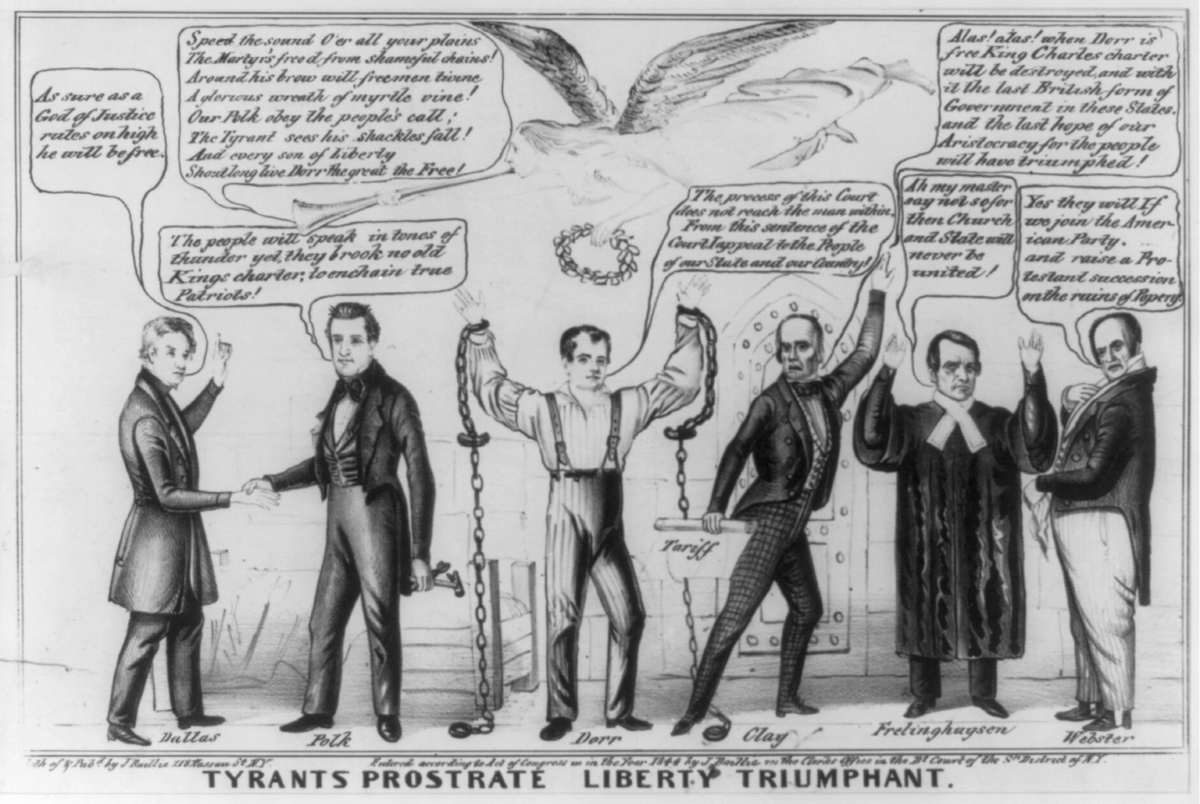The Toledo War – When Michigan and Ohio Nearly Killed Each Other Over a Strip of Land

Picture this: it’s 1835, and two entire states are mobilizing militias to fight over a piece of land that’s barely eight miles wide. The Toledo War was a boundary dispute between Ohio and Michigan over what is now known as the Toledo Strip, a 468-square-mile region that both states claimed. When Michigan petitioned for statehood in 1835, both sides passed legislation attempting to force the other’s capitulation, with Ohio’s Governor Robert Lucas and Michigan’s 24-year-old “Boy Governor” Stevens T. Mason instituting criminal penalties for residents submitting to the other’s authority.
Both states deployed militias on opposite sides of the Maumee River near Toledo, but the single military confrontation ended with shots being fired into the air, incurring no casualties, with only one non-fatal stabbing of a law enforcement officer. What makes this whole affair even more absurd is that Ohio raised 10,000 men while a Michigan newspaper welcomed them to enter the Toledo Strip and find “hospitable graves” there.
Bleeding Kansas – The Civil War’s Violent Dress Rehearsal

Bleeding Kansas was a series of violent civil confrontations in the Kansas Territory between 1854 and 1859, emerging from a political and ideological debate over the legality of slavery in the proposed state of Kansas. The conflict was characterized by years of electoral fraud, raids, assaults, and murders carried out by proslavery “border ruffians” and antislavery “free-staters,” with 56 political killings documented during the period, though the total may be as high as 200.
‘Bleeding Kansas’ was a term coined by the New York Tribune in 1856, and the factional violence clearly showed that the issue of slavery could only finally be dealt with through military action. On May 21, 1856, hundreds of border ruffians crossed into Kansas and entered Lawrence to wreak havoc, setting fire to buildings and destroying the printing press of an abolitionist newspaper, officially igniting a guerrilla war.
The Utah War – When America Almost Invaded the Mormons

The Utah War (1857–1858), also known as the Utah Expedition or Buchanan’s Blunder, was an armed confrontation between US government forces and Mormon settlers in the Utah Territory, lasting from May 1857 to July 1858. Although the war featured no significant military battles, it included the Mountain Meadows Massacre, where Mormon militia members disarmed and murdered about 120 settlers traveling to California.
The war with the Mormons ended up requiring one third of the U.S. Army, with the Army sustaining 38 casualties along with an unknown number of Mormons, and Buchanan was forced to end the war with a blanket pardon on all the Mormons. The whole thing started because of tensions over Mormon polygamy and governance, making it one of the strangest conflicts in American history.
The Dorr Rebellion – Rhode Island’s Mini Civil War

The Dorr Rebellion (1841–1842) was an attempt by residents to force broader democracy in Rhode Island, led by Thomas Wilson Dorr to demand changes to the state’s electoral rules. Rhode Island was still using its 1663 colonial charter as a constitution, which required land ownership as a qualification to vote, unlike most states which had created new constitutions during the American Revolution.
Armies took the field on both sides, but somehow they never managed to find each other, with the rebellion lasting two months without a single battle being fought and resulting in a single death—an innocent civilian shot by mistake. By 1840, the proportion of white men who could vote had shrunk to 40%, making this rebellion about basic democratic rights that we take for granted today.
The Colorado Labor Wars – When Companies Waged War on Workers

The Ludlow Massacre was an attack on striking coal miners and their families by the Colorado National Guard and Colorado Fuel and Iron Company guards at Ludlow, Colorado, on April 20, 1914, resulting in the deaths of 25 people, including 11 children. Soldiers from the Colorado National Guard and private guards attacked a tent colony of roughly 1,200 striking coal miners and their families, with approximately 21 people killed, primarily miners’ wives and children.
Called the “bloodiest civil insurrection in American history since the Civil War,” the Colorado Coalfield War was notable for the number of company-aligned dead, with an estimated 69 to 199 people dying during the strike. Armed miners attacked dozens of mines and other targets over ten days, killing strikebreakers and engaging in skirmishes with the National Guard along a 225-mile front from Trinidad to Louisville.
The Anti-Rent Wars – New York’s Feudal Uprising

The Anti-Rent War was a tenants’ revolt in upstate New York between 1839 and 1845, with Anti-Renters declaring their independence from the manor system run by patroons, resisting tax collectors and demanding land reform. This conflict arose because parts of New York still operated under a feudal system where wealthy landowners controlled vast estates and charged rent to tenant farmers.
The rebellion got so intense that tenants disguised themselves as “Calico Indians” to avoid identification while resisting rent collectors. One Anti-Renter was convicted for murdering Undersheriff Osman Steele and was sentenced to death, which was later commuted to life in prison. The whole affair sounds like something from medieval Europe, but it happened right here in 19th-century America.
Range Wars – The Forgotten Battles of the American West

Range wars were violent conflicts, most commonly in the 19th and early 20th centuries in the American West, over control of “open range” land used for cattle grazing or sheep pasture, typically involving disputes over water rights, grazing rights, or cattle ownership. Range wars included the Pleasant Valley War, Colfax County War, Johnson County War, Pecos War, Fence Cutting Wars, Sheep Wars, and others.
These weren’t just random shootouts between cowboys – they were organized conflicts that sometimes involved hundreds of armed men fighting over economic resources. The cattle barons had their hired guns, while smaller ranchers and farmers formed their own militias. It was like having multiple mini civil wars scattered across the frontier, each one determining who would control the land and water that meant survival or wealth.
The Johnson County War – Wyoming’s Invasion

The Johnson County War of 1892 was perhaps the most organized of all the range wars, involving what was essentially a private army invasion of Wyoming. Wealthy cattle barons hired gunmen from Texas and invaded Johnson County to eliminate supposed cattle rustlers and their sympathizers. The “invaders” had a hit list of over 70 people they planned to kill.
What makes this particularly shocking is that the invaders had the backing of powerful politicians and even some federal officials. They expected to ride in, eliminate their enemies, and ride out as heroes. Instead, they found themselves surrounded by angry local residents and had to be rescued by federal troops. The whole affair exposed the corruption and violence that powerful interests were willing to use to maintain control.
The Pleasant Valley War – Arizona’s Bloodiest Feud

The Pleasant Valley War, also known as the Graham-Tewksbury Feud, raged in Arizona’s Tonto Basin from 1882 to 1892. What started as a dispute between sheep and cattle interests turned into a decade-long blood feud that nearly wiped out two entire families. One of the most famous gunfights in the history of the Old West took less than one minute, but it was only one battle in this extended conflict.
The war was so vicious that it became legendary even by Wild West standards. Entire families were hunted down and killed, with the violence escalating far beyond any rational economic dispute. By the end, the Pleasant Valley had earned its reputation as one of the deadliest places in America, where neighbor turned against neighbor in a cycle of revenge that seemed to have no end.
The Battle of Blair Mountain – America’s Largest Labor Uprising

The Battle of Blair Mountain is considered the largest labor uprising in the U.S. by number of combatants. This 1921 conflict in West Virginia involved over 10,000 armed coal miners fighting against company forces and law enforcement. The miners were literally at war with the coal companies that controlled their lives, their towns, and their government.
The federal government had to send in the military to end the fighting, treating American workers like they were foreign enemies. The miners had organized themselves into military units, complete with commanders and battle plans. For several days, the mountains of West Virginia echoed with machine gun fire and explosions as American fought American over the basic right to organize labor unions.
Lesser-Known Civil War Battles That Changed Everything

The first known use of African American combat troops during the Civil War occurred at the Skirmish at Island Mound, October 27-29, 1862, when the 1st Kansas Colored Infantry Regiment deployed against Missouri guerillas. Union Captain James M. Williams had recruited a regiment of former slaves and free Black men as the 1st Kansas unit, training them as militia while the Union army had not yet decided on recruiting African American units.
Dozens of lesser-known fights moved the tide of victory back and forth and set the stage for the bigger conflicts. These forgotten battles often determined the outcomes of major campaigns, yet most Americans have never heard of places like Rich Mountain, Philippi, or Kernstown. Each of these engagements shaped the war’s direction in ways that the famous battles like Gettysburg simply built upon.
The Real Impact of America’s Hidden Wars

What’s truly shocking about these forgotten conflicts is how they shaped American democracy, labor rights, and western expansion in ways that most history books ignore. The Dorr Rebellion foreshadowed fundamental questions that would later frame the Civil War, forcing people to debate the true meaning of the Declaration’s promise that all men are created equal.
Although not a direct cause of the Civil War, Bleeding Kansas represented a critical event in its coming, with Republicans using the events to build their base while the violence widened the divide between northern and southern Democrats. These “other” civil wars weren’t just regional squabbles – they were the testing grounds for the ideas and conflicts that would eventually tear the entire nation apart.
The bloodshed in places like Ludlow, Colorado, and Blair Mountain, West Virginia showed that the struggle for workers’ rights would require the same kind of sacrifice as the fight for political freedom. When you look at all these conflicts together, you realize that America has been fighting civil wars almost continuously since its founding – we just never called them that.






